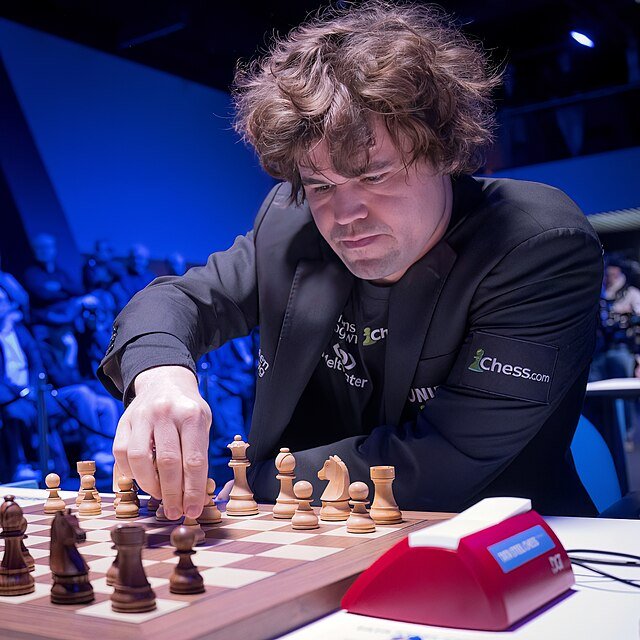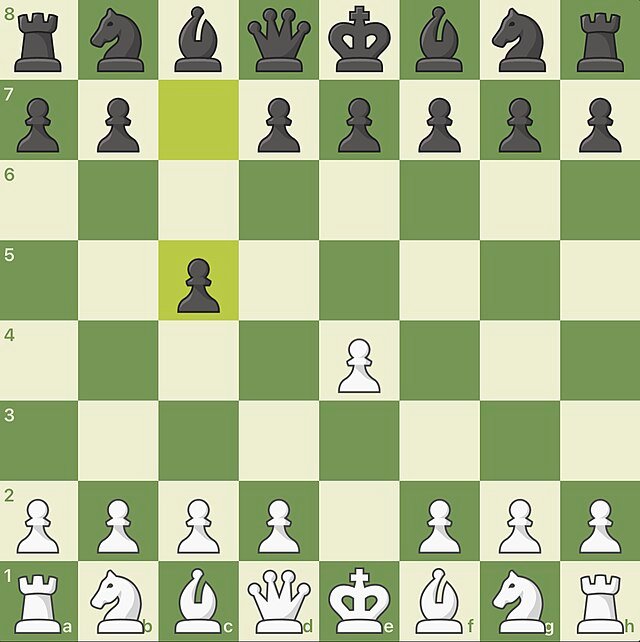
Magnus Carlsen
About Magnus Carlsen
Magnus Carlsen is a Norwegian chess grandmaster, considered one of the greatest players in history. Famous for his universal style, he combines deep preparation with outstanding endgame skill and the ability to turn small advantages into victories.
Introduction to the Sicilian Defence
The Sicilian Defence starts with 1. e4 c5. It is one of the most popular replies to 1. e4, creating rich and dynamic positions. Instead of mirroring White, Black plays for counterattack, leading to sharp, imbalanced middlegames with chances for both sides.

Game 1
This game was played in the Sicilian Defence, with Magnus Carlsen as Black. Both players followed standard theory until move 15, where Carlsen calmly developed and prepared counterplay in the center.
- Opening: Sadhwani played the Closed Sicilian setup with g3, but Carlsen responded actively with …Bc5 and …Ba7.
- Middlegame: Carlsen’s 15...Nd4 created pressure, forcing White into defensive moves. His queen infiltrated with 17...Qb6 and captured the pawn on b2.
- Critical Moment: After 20. Nd5?, Carlsen played the strong 20...Bxd5 followed by 21...Nxc2, winning material and ending the game quickly.
- Result: White resigned as Black’s knight fork on c2 was decisive.
A clean and instructive game by Carlsen, showcasing how precise piece activity and central control in the Sicilian can punish even small inaccuracies.
Game 2
Magnus Carlsen, playing Black in the Sicilian Defence, showed excellent strategic control. Early on, he equalized comfortably after exchanges in the center and gradually expanded on the queenside while keeping his king safe.
- Opening: The game began with a Classical Sicilian setup. After early trades, Black gained an active bishop pair and central harmony.
- Middlegame: Carlsen activated his pieces with …h5, …Rh6, and …Rf6, building pressure against White’s kingside while keeping control over the d-file.
- Transition: Exchanges led to a rook and minor piece ending where Carlsen’s pawns advanced powerfully. His bishops and rooks coordinated to restrict White’s play.
- Endgame: Carlsen steadily pushed his pawns, used activity of his rook on the 2nd/3rd ranks, and converted the advantage with precise technique. White’s pieces were forced back, and Carlsen’s kingside pawns rolled forward decisively.
The game is a model example of how Magnus Carlsen transforms small advantages into a winning endgame. Step by step, he outmaneuvered his opponent until resignation became inevitable.

Game 3
Magnus Carlsen, with the Black pieces, handled this Sicilian Defence blitz game with characteristic precision. The opening developed into a typical structure where Carlsen exchanged pieces early and steered into a practical middlegame.
- Opening: After 8…Nxd4 and 9…Bc5, Black simplified and equalized comfortably, trading queenside pressure for activity.
- Middlegame: Carlsen centralized his pieces with …Rc8, …Ke7, and …Rhd8, keeping balance while White advanced pawns on the kingside. His calm moves like …h5 and …g6 neutralized White’s space advantage.
- Turning Point: Around move 30, Carlsen opened the position with …fxg5 and defended precisely. The tactical sequence beginning with 32…Bxd5 allowed him to exchange into a better ending.
- Finish: With his queen and knight coordinated, Carlsen’s counterattack forced White’s king forward. The decisive blow came after 44…Qg1+, leaving White with no safe squares and resigning immediately.
A fine example of Carlsen’s blitz strength: patient defense, timely counterstrike, and accurate calculation to convert into victory.
Game 4
Magnus Carlsen, as Black, chose the Sicilian Defence and quickly grabbed the initiative. After White’s early push with f4–f5, Carlsen calmly exchanged pieces and struck back with precise play.
- Opening: White’s aggressive setup with f4 and e5 aimed at an attack, but Black’s solid replies like …Nd7 and …Nc5 neutralized it.
- Middlegame: The critical moment came when Carlsen captured on b2 and countered on the queenside. White tried to keep initiative with Rb8 and kingside pawn pushes, but Black defended accurately.
- Turning Point: Carlsen’s resourceful defense with …Be6 and …Qa5 left White’s king exposed while his own threats grew.
- Finish: In time pressure, White’s attack fizzled. Carlsen launched a decisive counter with 31…Qe1+ and 32…Be5+, forcing resignation as mate was unavoidable.
A sharp tactical battle where White attacked energetically, but Carlsen’s calm calculation turned the game around, showing his strength in handling complications.
Game 5
Magnus Carlsen once again demonstrated his class with the Sicilian Defence. After White’s quiet 5.g3, Carlsen struck in the center with …d5, immediately challenging White’s setup.
- Opening: White aimed for a fianchetto system, but Carlsen’s energetic …d5 and quick development gave him full control of the center.
- Middlegame: The move 12…d4 forced White’s pieces backward. Carlsen expanded actively with …Bc4 and …Bd5, gaining space and initiative.
- Turning Point: Carlsen’s knight jump to e4 and queen maneuver to h3 put White’s king under heavy pressure. White’s pieces were passive, while Black’s attack grew stronger with every move.
- Finish: The tactical blow came with 28…Qxd1, followed by 29…Re1. White was left completely lost, as mate or huge material loss was unavoidable.
A smooth attacking game where Carlsen neutralized White’s quiet setup and converted it into a direct kingside assault, finishing with a clean tactical shot.
Game 6
Magnus Carlsen once again showed his precision and ability to punish the smallest inaccuracies. Santos Latasa entered the Sicilian Defence with a flexible setup, but Carlsen’s strategic ideas and tactical sharpness gradually took over.
- Opening: White played solidly with 5.Bd3 and 6.O-O, but Carlsen’s setup with …a6, …Qc7, and …b6 prepared a typical hedgehog-style counterplay.
- Middlegame: Carlsen launched kingside activity with …Nh5 and …Bh6. After 19.Ng5 e5!, Black seized the initiative. White’s decision to sacrifice on b6 looked ambitious but backfired as Carlsen’s pieces became more active.
- Turning Point: The sequence 21…Nf4! and 22…N6h5! was a masterstroke, doubling pressure against White’s kingside. Carlsen’s rooks and queen quickly joined the attack, while White’s pieces were scattered.
- Finish: The final attack came with 31…f3 and 32…fxg2. Carlsen’s passed pawns and threats against the White king were unstoppable. The game ended with a forcing sequence: 37.d7 Qh1+ 38.Kf2 Rc2+ 39.Ke3 f4+, leaving White completely lost.
A brilliant attacking game where Carlsen combined positional understanding with sharp tactics. From a balanced opening, he slowly tightened the grip, then launched a crushing kingside offensive to secure victory.
Game 7
Magnus Carlsen, playing Black, responded to Wesley So’s 1.e4 with the Sicilian Defence. The game quickly entered a sharp line where Carlsen gained counterplay in the center with ...d5 and ...Nf6. So tried to stabilize with solid moves like Be3 and Re1, but Carlsen’s piece activity and central control kept mounting. By move 22, Carlsen jumped in with his knight to e4, creating constant tactical threats. So’s rook maneuvers between e3 and b3 failed to make progress, allowing Carlsen to regroup and slowly outplay him. The breakthrough came after 33...g5, when Carlsen opened the kingside, seized the initiative, and converted into a winning attack. Finally, after 43...Qxg3, Wesley So resigned as his king was completely exposed and Black’s attack was decisive. A fine demonstration of Carlsen’s ability to turn small imbalances into a powerful attack.

Game 8
Magnus Carlsen, with Black in the Sicilian, steered the game into an unbalanced middlegame and then squeezed with precise, active play. White’s early queen maneuvers (Qg4–Qe3) let Carlsen gain tempi and set up a kingside clamp.
- Opening: After the flexible setup with …a6, …Bc5, and …Be7, Black neutralized ideas like Bf4/Bh6 and fixed the center with …d6. The move 14…g5 followed by 15…Rg8 announced play on the kingside.
- Middlegame plan: Carlsen regrouped pieces and expanded: …h6–h5, …g4, and the powerful pawn wedge …g3 cramped White’s king. Meanwhile he gained space on the queenside with …b5 and …a5–a4, keeping both wings under pressure.
- Critical phase: After 28.fxg3 Ng4 29.Qe1 a4 30.Nc1, Black seized the initiative on both flanks and calmly exchanged queens with 35…Qxg1+, reaching a superior endgame where his pieces were far more active.
- Conversion: In the rook–minor piece ending, the tactical shot 40…Rxe4! (undermining White’s structure) and the follow-up 41…Bxe4 42.Nxe5 Bxb1 netted material and left Black’s forces dominating open files. Precise technique with …Rc5, …Rd5, …e5, …f6 tightened the bind; with his king cut off and pawns falling, White resigned after 52…Kf5.
Instructive model of Carlsen’s style: create pressure on both wings, force concessions, simplify into a better endgame, and convert with energetic piece activity.